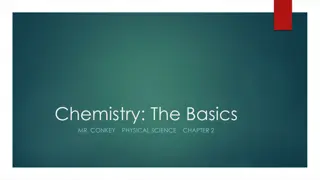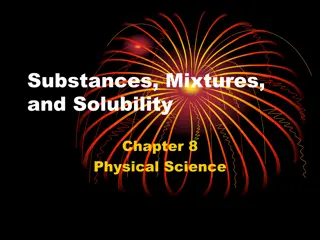Understanding Atomic Structure, Elements, Mixtures, and Compounds
Exploring the basics of atomic structure, including elements, mixtures, and compounds. Learn about single atoms, molecules of elements, and compounds formed by different elements. Understand the relationship between protons, neutrons, electrons, atomic number, and atomic mass. Test your knowledge on identifying different types of substances and calculating subatomic particles in atoms.
Download Presentation

Please find below an Image/Link to download the presentation.
The content on the website is provided AS IS for your information and personal use only. It may not be sold, licensed, or shared on other websites without obtaining consent from the author. Download presentation by click this link. If you encounter any issues during the download, it is possible that the publisher has removed the file from their server.
E N D
Presentation Transcript
Week 1 Atomic Structure Elements, Mixtures and Compounds Atoms and molecules Remember that an element is one type of atom, like carbon, gold or chlorine. We will look at three ways that atoms can exist. 1. Single atoms The atoms of some elements do not join up with other atoms. They stay as single atoms. The element helium is like this. Helium atoms do not join up with each other or any other element and it is a gas. Helium atom 2. Molecules of elements When atoms of the same element join together we get a molecule of that element. 3. Compounds A compound is made when atoms of different elements join together by chemical bonds. This means that compounds will always exist as molecules, not separate atoms. The diagrams show some molecules of common compounds. 1
What is a mixture? A mixture is made from different substances that are not chemically joined. In summary: Test yourself Task: Write the correct letters below. 1. 1 type of element: _________________________________________ 2. 1 type of compound: _____________________________________ 3. Mixture of elements: _______________________________________ 4. Mixture of compounds: ____________________________________ 5. Mixture of elements and compounds: _______________________ Challenge: 1. Which letter is showing molecules of elements? 2. Which letters are showing gases? 3. Which letter is showing a solid? 2 4. Which letter could be showing water (H2O)
Structure of the atom, atomic mass and atomic number Atomic structure All substances are made from tiny particles called atoms. An atom has a small central nucleus made up of smaller sub-atomic particles called protons and neutrons. The nucleus is surrounded by even smaller sub-atomic particles called electrons Protons and electrons have an electrical charge. Protons are positive, electrons are negative. Neutrons are neutral. The number of electrons in an atom is equal to the number of protons in its nucleus. This means atoms have no overall electrical charge. Atomic number and atomic mass The atomic number of an atom is the number of protons it contains. The atoms of different elements have different numbers of protons. For example, all oxygen atoms have 8 protons and all sodium atoms have 11 protons. The atomic mass (or mass number) of an atom is the total number of protons and neutrons it contains. Challenge: Calculating the number of subatomic particles in each atom using the atomic number and the atomic mass. The symbol on the right tells you that chlorine has 17 protons. This is because the atomic number is 17. In an atom, the number of protons is equal to the number of electrons, so chlorine contains 17 electrons. Atomic mass To work out the number of neutrons, you subtract (take away) the atomic number from the mass number. Atomic number 35 17 = 18 So, chlorine has 18 neutrons! 3
Test yourself Task 1: Look Cover Write Check Information 1st try 2nd try The atomic number is the number of protons an atom contains. The atomic mass is the total number of protons and neutrons an atom contains. The atomic number is the number of The atomic mass is the total number of In an atom In an atom, the number of protons is the same as the number of electrons Task 2: Label the protons, neutrons and electrons in the diagram below. Task 3: Complete the table below. Challenge: Sodium has an atomic number of 11 and a mass number of 23. 1. How many protons does it have? 2. How many electrons does it have? 4 3. How many neutrons does it have?
Calculating the number of each subatomic particle and learning about isotopes Calculating the number of subatomic particles The symbol on the right tells you that iron has 26 protons. This is because the atomic number is 26. In an atom, the number of protons is equal to the number of electrons, so iron contains 26 electrons. Atomic mass Atomic number To work out the number of neutrons, you subtract (take away) the atomic number from the mass number. 56 26 = 30 So, iron has 30 neutrons! Isotopes Isotopes are the atoms of an element with different numbers of neutrons but the same number of protons. This means that they have the same atomic number (proton number) but a different atomic mass. 1 proton 0 neutrons 1 electron 1 proton 1 neutron 1 electron 1 proton 2 neutrons 1 electron Test yourself Task 1: Fill in the missing words. The key words are provided below: The smallest particle of an element is called an _____________. The ______________ is in the centre of an atom. Electrons have a ____________________ charge and protons have a _____________________ charge. The atomic number is the number of _____________________ in an atom. The Atomic mass is the total number of __________________ and ________________ inside an atom. For an isotope, the atoms have the _________________ number of protons but ___________________ number of neutrons. Same Protons Negative Atom Protons Different Nucleus Neutrons Positive
Task 2: The picture on the right shows an oxygen atom. Oxygen has an atomic number of 8 and an atomic mass of 16. Using the picture and the information to help you, answer the following questions. An oxygen atom contains ________ protons. An oxygen atom contains ________ electrons An oxygen atom contains ________ neutrons. Task 3: Complete the table using the pictures to help you. Remember, the top number shows atomic mass and the bottom number shows the atomic number. The first row has been done to help you! Name Sodium Symbol Protons Neutrons 23 11 = 12 Electrons Na 11 11 P 6 7 20 2 2 2 Task 4: The table below shows isotopes of carbon. Each carbon atom has an atomic number of 6 but different atomic masses. State the number of electrons, protons and neutrons in each isotope of carbon. Carbon-12 Carbon-13 Carbon-14 No. of protons = No. of electrons = No. of neutrons = No. of protons = No. of electrons = No. of neutrons = No. of protons = No. of electrons = No. of neutrons = 6























